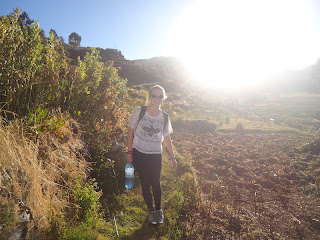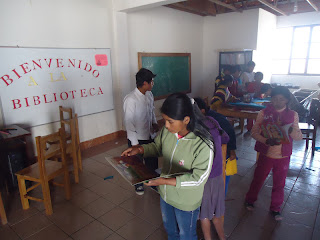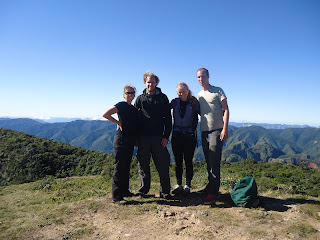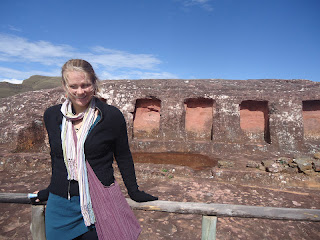 |
| Atop of Isla del Sol on Lake Titicaca |
This
weekend I decided to "splurge" and reward myself for being over halfway
through my time in Bolivia (!!!) by taking a weekend trip to Lake
Titicaca. The reason why this was a splurge is because I flew. If I had
taken the bus I would have left Friday night, arrived twelve hours later
on Saturday morning, and still had six hours of travel ahead of me
before reaching my final destination. By flying I was able to leave
Friday afternoon. I flew out of Sucre to Cochabamba, ten hours by bus
but get this, in preparation for takeoff our flight attendant said, "the
flight duration is twenty-five minutes." From Cochabamba to La Paz was
only thirty-five minutes. So my total flight time was 1 hour and 10
minutes– but it takes twelve hours by bus. Oh, Bolivian roads how we all
love you. Besides saving time, flying gave me the most beautiful views
of Bolivia. Since both my flights were so short we hardly gained
elevation so it felt as though the plane was barely skimming the
mountain tops. My first flight was over dry, dusty, red canyons and
hills and the second was over the Cordillera Real Range– enormous snow
capped mountains. I saw a lot of these in the next few days.
 |
Because Lake Titicaca is at such a high elevation it looks right
onto the Cordillera Real Range– creating a stunning view. This picture
is dark because I adjusted the exposure to capture the mountain.
|
I
arrived in La Paz, made my way to the bus station, and immediately got
on a minibus to Copacabana– my first destination of my trip. Copacabana
is on the shore of Lake Titicaca; however this seems more like an ocean
than a lake, covering just under 8,400 square kilometers (3,230 square
miles). And here comes the height bit: it is at 3,800 meters (12,480
feet) above sea level. Copacabana is really quite a tourist driven town–
lots of shops and an unimaginable amount of restaurants all advertising
trucha. Trout. I was so happy to have fish– I wouldn't dare eat any fish

served
anywhere else in Bolivia since it is a landlocked country and it would
hardly be fresh. I had trout three days in a row– and loved it every
time. Such a nice change of pace compared to what I've been eating.
Copacabana wasn't my final destination– I was meeting my friend
Charlotte at Isla del Sol, an hour and a half boat ride away. Boats only
run at 8:30 a.m and 1:30 p.m and since I arrived at 6 I couldn't leave
until Saturday morning. I spent my evening watching the sunset while
eating my trout, sipping Bolivian wine, and journaling. It was a nice
evening.
Saturday
I boarded a small boat to Isla del Sol, which is supposedly the
birthplace of Inti, the Andean deity of the sun. Incas believe the sun
came from Isla del Sol. Many indigenous Bolivians believe their creation
story to be that after the sun was in the sky it ordered the first
Incas to appear on Isla del Sol. Now, the island has 2,500 inhabitants
and only footpaths– there are no cars. It is relatively small, although
after my adventure on Saturday I may argue that it really isn't that
small. I met Charlotte on the south island where she had stayed the
night before and I would be joining her for the second night. We sat and
chatted for a bit before starting our "three hour"

trek
across the island to the north side, where we planned on getting a late
lunch, checking out the Inca ruins, and then heading back. I would
usually call this a big fail since that isn't at all what happened. Our
plan went haywire. However, I can't really complain because we were
still walking around a beautiful island with great company; the day
wasn't a fail, it just didn't go according to plan. Basically the reason
why we got so turned around is because we missed a hairpin turn and
ended up following a sheep path to the very point of the island instead
of the human path that would bring us to food. That was problematic as
we left at 11, and by the time we finally got to the town where food was
it was 3:30. It was maybe the best sandwich I had ever had (it was only
an egg with a tomato) since by that point the only thing that I had
eaten all day long was a banana and we had been walking for four and
half hours. Ay, ay, ay. And we still had to make our way back, this time
on a different path. We got lost again, this time not our fault at all
because a little girl pointed us in the completely wrong direction.
 |
| Where are we?! Getting lost round number one. |
 |
| We made lots of donkey friends. |
 |
This is right outside (and below) our hostel. I think this was
the first photo I took when I arrived. Look at the mountains
in the background! |
 |
| At least it is a pretty place to get lost. Charlotte still looks happy! |
By
6:00 we were both a little concerned as the temperature and sun were
both dropping rapidly. By this point we were trekking through gardens,
fields, and up and over mountains with only sheep, donkeys, and llamas
for company. We both admitted later that we had been preparing ourselves
to knock on the next hut we saw and ask if we could spend the night if
we had to. Finally, someone pointed us in the right direction and we
made it back at 6:30, right when the sun was going down. Seven and a
half hours of nonstop walking. So folks, that is how I went to Isla del
Sol and was able to miss out on most of the Inca ruins. At least I saw
the natural beauty of the island. And we saw some of the ruins, so it
wasn't a complete fail.
The next morning we had breakfast looking out onto this view:

It
turns out the husband of the owner of the hostel/restaurant was going
to Copacabana to run errands so Charlotte and I caught a ride with him;
our own private boat! And he was kind enough to stop for twenty minutes
while we took pictures at some ruins. In Copacabana I had my last meal
of trout, said goodbye to Charlotte who is headed to Peru, and I made my
way back to Sucre, semi-arriving at 6:30 this morning. Why
semi-arriving... well there were blockades and strikes this morning.
Dozens and dozens of tractor trailer trucks were parked perpendicular to
the road so no one could get through. We had to get off the bus about
two kilometers from Sucre and walk with our luggage until we were
through all the blockades and could catch a micro, the local buses.
Someone told me it was the Union striking, but I don't know what it was
all about. There were strikes later this day– people marching through
the streets and yelling. I try to avoid it all.
 |
| Boom. Inca ruins. |
 |
More Inca ruins. Look at the color of the
water behind me! It is such a bright blue. Many
people compare Isla del Sol to the Mediterranean.
I wouldn't know– but it seemed like paradise!
|
|
 |
| Inca steps. |
 Since I arrived in Sucre my plan was to start a school/library garden in Pampa Aceituno. I see a garden as a way for students to learn how to raise vegetables, study plant biology, understand the importance of a healthy diet, and as a plus, all the vegetables they grow will directly benefit the school. The mothers who cook for the entire student body will use the vegetables from the school garden. Consequently, a garden would not only strengthen the academics, but the school environment as well.
Since I arrived in Sucre my plan was to start a school/library garden in Pampa Aceituno. I see a garden as a way for students to learn how to raise vegetables, study plant biology, understand the importance of a healthy diet, and as a plus, all the vegetables they grow will directly benefit the school. The mothers who cook for the entire student body will use the vegetables from the school garden. Consequently, a garden would not only strengthen the academics, but the school environment as well.

















































